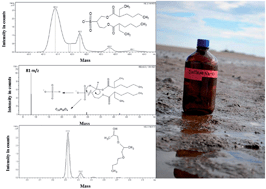Determination of COREXIT components used in the Deepwater Horizon cleanup by liquid chromatography-ion trap mass spectrometry
Abstract
The oil spill dispersant, COREXIT 9500, used in the BP Deepwater Horizon oil spill, was analyzed by high-performance liquid chromatography-ion trap mass spectrometry with electrospray ionization. Two components present in the mixture, dioctyl sodium sulfonate (DOSS) and dipropylene glycol butyl ether (DGBE), were recovered from spiked ocean water samples. Compounds were isolated from ocean water spiked with COREXIT 9500 by solid phase extraction using C18 cartridges prior to separation with high performance liquid chromatography-ion trap mass spectrometry using an acetonitrile and 0.1% formic acid gradient. Both compounds were identified using a simultaneous extraction procedure. Dioctyl sodium sulfonate is identified by negative electrospray-ion mode, and dipropylene glycol butyl ether by positive electrospray-ion mode. This method identifies trace levels of dispersants used in oil-spill cleanup efforts through the identification of two major components, which could provide validation for the correct identification of a dispersant mixture. This method was validated by recovering COREXIT components from spiked natural ocean water samples collected in the Gulf of Mexico. Oil-impacted ocean water samples were collected in Grand Isle, Louisiana at an oil-impacted beach, but no traces of COREXIT were identified.

- This article is part of the themed collection: Emerging analytical methods for global energy and climate issues

 Please wait while we load your content...
Please wait while we load your content...